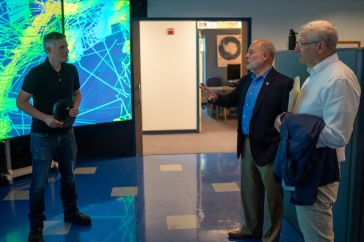
To study plants' changing ability to mitigate climate change, Jingfeng Xiao and his collaborators examined data from a global monitoring network called FLUXNET and developed models for five major biomes, including grasslands. Photo by Fei Li.
Plants may not be the superheroes of climate change mitigation scientists once thought. The widely accepted assumption was that as levels of carbon dioxide (CO2) in the atmosphere rapidly rise and climate changes, plants use less water but absorb more carbon. But new findings from UNH, published in the journal Science, found this trend stalled in 2001, implying plants were consuming more water and not as much CO2.
“This study shows that some of the nature-based methods that scientists thought might ... help achieve carbon neutrality may be undermined by the adverse effects of climate warming.”
“An increase in CO2 allows green plants to grow faster and use water more efficiently but this study shows that some of the nature-based methods that scientists thought might be in place to help achieve carbon neutrality may be undermined by the adverse effects of climate warming and that plants are not using water as efficiently as scientists might have expected,” says Jingfeng Xiao, research professor in UNH’s Earth Systems Research Center. This change in what’s known as water use efficiency (WUE) could have implications on climate mitigation, carbon cycling, agricultural production and water resources.
Plants’ carbon-sucking slacking is a relatively recent phenomenon, Xiao and his collaborators found. “We observed an overall significant increase in water use efficiency throughout 1982 to 2016, with a substantial rise from 1982 to 2000, but after that water use efficiency seems to have stalled,” Xiao says.
The researchers say this stalling water use efficiency is possibly due to rising vapor pressure deficit (VPD), the amount of water actually in the air versus the amount of water vapor the air could hold. As VPD increases, it potentially slows or suppresses photosynthesis and enhances plant water consumption, weakening plant growth and decreasing water use efficiency in global ecosystems.
To reach their conclusions, Xiao and his collaborators examined satellite and micrometeorological data from a global monitoring network called FLUXNET, harnessing machine learning to develop models for five major biomes: forests, shrublands, savannas, grasslands and croplands. They looked at potential influences and limitations in each ecosystem on CO2 uptake and found the saturation of WUE did not appear to be the result of changes in vegetation regrowth, land cover or nutrient constraints on photosynthesis like too much or too little nitrogen or phosphorus.
The researchers caution that because of climate change, plants may not blunt the effects of climate change as we once thought. “Human reliance on nature-based carbon sinks to achieve carbon neutrality and to mitigate climate change may be undermined by the adverse effects of climate warming,” they conclude.
In addition to Xiao, study authors are Fei Li, Chinese Academy of Agricultural Sciences (lead author); Jiquan Chen and Michael Abraha, Michigan State University; Ashley Ballantyne, University of Montana; Ke Jin and Bing Li, Chinese Academy of Agricultural Sciences; and Ranjeet John, University of South Dakota.
-
Written By:
Beth Potier | UNH Marketing | beth.potier@unh.edu | 2-1566 -
Written By:
Robbin Ray ’82 | UNH Marketing | robbin.ray@unh.edu | 603-862-4864

















































